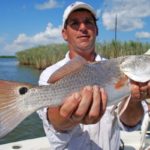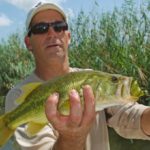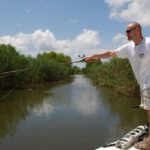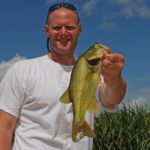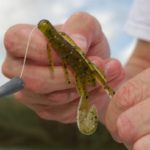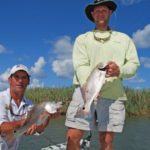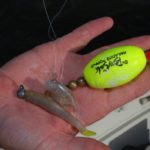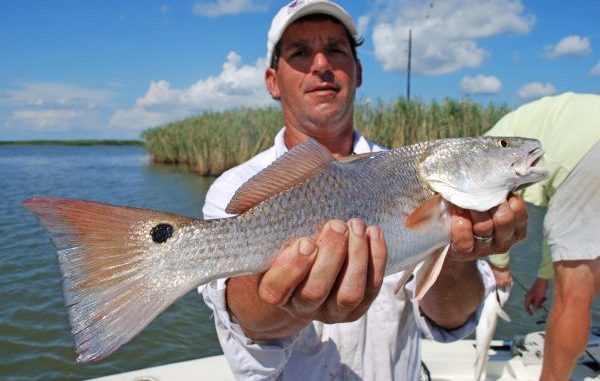
In many places, anglers are forced to target freshwater or saltwater species. But in Venice, the same waters that hold bass are home to redfish.
Everywhere I went, I kept running across this guy selling ice chest hinges.
Ice chest hinges?
Finally, at one event I ended up seated next to Eric Pendarvis. So waddaya talk about to a guy who sells ice chest parts?
Fishing, of course. There isn’t a lot you can say about beer.
He got my attention — pronto!
“I like to fish in Venice because it’s Venice,” he said. “There is so much to do. If you take what Mother Nature gives you, you will never go hungry. If the wind isn\’t blowing for duck hunting, you can slip up on some hogs. It’s super easy to stomp out some rabbits — super easy.
“You can gig for flounder. You can fish for snappers, or you can fish for bass. Of course, there are always specks and reds. When the river is low (from August to October), I can catch all the bass and redfish I want in the same day.
“We have a camp; you wanna go?”
A couple of months later, I was south of Venice on the Mississippi River heading toward the end of the world. The 24-foot aluminum Gravois hull we were in belongs to Pendarvis’ fishing partner, Daniel Loup. The two men know each other because their families own adjacent camps on Don\’s Ditch, a private canal in the heart of the delta.
The 41-year-old Pendarvis has pulled hitches as a charter and eco-tour guide, but until recently spent much of his life working for his father, Dempsey Pendarvis, who owns the general contracting Depen Company, as well as an angus cattle herd.
Now, Guided Solutions, the parent company that houses his Gorilla Hinges, takes up a lot of his time.
Thirty-three-year-old Loup can best be described as an outdoors nut (part of his e-mail address is “grouperloup.” The Jacob’s Engineering project control manager fishes Venice almost every weekend in the summer, targeting trout, redfish and bass, with “quite a bit” of rig-fishing for snappers and amberjacks and some tuna fishing mixed in.
He describes himself as an “addicted bow hunter” in the winter, and hunts hogs in Venice in February and March.
Our strategy, the two men explained, was to fish for bass the first afternoon on a falling tide, and then target redfish in the morning on an incoming tide.
Marsh bass, the pair explained, like to get deep into the tall roseau cane when they can, making them impossible to fish for. But low tide forces them out to the cane edges, so the best bass fishing is during the last two hours of a falling tide.
The bass fishing would be done in very small bayous, different than what are locally referred to as “spillways.” Called “distributaries” by hydrologists, both of these waterways funnel river water from passes out to bays and lagoons that open into the Gulf of Mexico.
The first bayou the pair stopped at was on the east bank of the main river right before Main Pass.
Both men used crawfish-pattern plastic baits because bass on the delta feed heavily on crawfish and crabs, although Loup allowed that plastic worms will work, as well. Loup tied on a watermelon/red Zoom Speed Craw and Pendarvis a watermelon/black Baby Brush Hog.
Both baits were rigged Texas style with a 3/0 worm hook and a 3/8-ounce sliding weight. The heavy sinker allows better bait control and pulls the bait through the canes to the bottom quickly.
Not a single typical long bass cast was made by either man; instead, while Loup maneuvered the boat down the small bayou, the men flipped their lures into any opening in the thick vegetation with an underhand swing of their rods.
When the lure hit the bottom, it was bounced and worked a couple of feet out from the vegetation, and then picked up for another “cast.”
“It\’s hard to feel taps,” Pendarvis said.
The fish tend to run toward you, so you have to watch your line for movement. And look for tiny, almost invisible cuts draining the marsh.”
The little 1- to 2-foot wide hotspots are almost unrecognizable.
“The real trick,” said Loup, “is to get your bait as far into the canes as possible.”
“This is normal Venice bass fishing,” grinned Pendarvis, “although at times we will also use spinnerbaits with willow-leaf spinners.”
Loup elaborated.
“My favorite (spinnerbait) is a Humdinger,” he said. “The willow leaf (blade) goes through grass better. We use spinners in grass beds in duck ponds, in drains coming out of duck ponds and on the edge of flats.”
Loup quickly boated a 2-pounder — big by marsh standards — but this bayou produced nothing else. In 20 minutes they lost patience and moved down the main stem of the river into South Pass, and then into the first bayou on the west side of the pass and then into a smaller cut off of it.
The action was hot in this tiny cut. The men snatched fish out of the canes regularly, although almost every cast resulted in hanging up in the canes because the cut was so narrow.
The canes shook, the fish flounced, and the anglers grimaced and levered fish out of the vegetation.
Loup called what they were doing “half finesse, half gorilla fishing.”
“When they bite you gotta be on them,” he said.
Neither man used a classic long flipping rod, explaining that in the tight spaces they often fish in “a long rod gets in the way.” Both agreed that the choice of spinning or casting equipment was a matter of personal preference, but Loup added that any rod used should be on the stiffer side.
Loup\’s reels were spooled with 30-pound-test braided line and 40-pound-test monofilament leaders. One of Pendarvis\’ reels was spooled with 20-pound braid and the other with 17-pound monofilament.
When a spot yielded three or four bites, Loup would turn the boat around to pass over the spot again, although the cut was so narrow that turning was difficult. The men set the hooks hard on every bite and dredged the fish out of the jungle in one motion.
The fish came out of the shaking canes and splashing water in a blinding blur. The anglers made it look ridiculously easy.
On the last fish of the limit — a ¾-pounder — Loup held it up.
“I\’m not a tournament fisherman,” he said. “I like 10 that size; I love to eat them. I like them better than sac-a-lait or snapper.”
And the options of where to fish are almost endless.
“Hundreds of these bayous hold bass like this,” Loup said. “The best bite will change constantly. Look for clean green water and move around.
“Other than that, I really don’t think there is a secret to catching Venice bass.”
The next morning after an awesome supper, I was sitting in the dark on the camp\’s steps, sharing a cup of Café Bustelo coffee with Pendarvis (who picked up the taste from Cubans while eco-guiding in south Florida), when Loup approached us from the direction of his camp.
Pendarvis took a swallow of the dark brew and sighed to no one in particular, “I love it down here.”
“No other place like it on earth,” Loup replied after a short silence. “You can catch bass, and then go catch red snapper.”
This day was reserved for red fish, or more properly redfish. The previous day was for green fish.
The anglers’ redfish rigs were simple and generic. Both use any type of a wire cork with rattling beads and a jighead set a couple of feet below the cork.
Loup uses a jighead with any type of Deadly Dudley plastic tail with a chartreuse tip and a pinch of shrimp on the hook. Pendarvis dispenses with the plastic and just uses a bare jig head and a bigger piece of shrimp.
For fishing in deeper water, the men simply dispense with the cork. This turned out to be the most productive rig of the day.
The men opened their fishing by concentrating in backs of spillways off of passes, around the islands of canes and especially where the spillways opened into flats and then into bays.
Loup used the trolling motor to constantly move and maneuver while they noisily popped their corks to attract attention to their baits.
Redfish are found in areas very near to where bass are found, but there are some subtle differences — largely based on the difference in size between spillways and bayous. Spillways are bigger and tend to be straighter.
Bass prefer small, winding bayous with less current.
Redfish are not commonly found along the edges of canes in spillways. The water tends to be too deep in spillway edges, and the water current is too strong. Redfish don’t hold where currents are strong, preferring to use areas on flats near grass beds and islands of canes.
The fish were few and most not up to the size standards of the anglers, so they shifted their attention upriver slightly to rock riprap on the banks of the river.
Again, the fish were few and not big enough.
The pair then ducked their boat into Pass-a-Loutre and began fishing the spillways off of the pass. They fished corkless in the deep opening of each cut and under corks in the back on the shallow flats.
On the third spillway, they hit the jackpot in the deep water at its mouth. Virtually every cast produced either redfish or black drum on shrimp-tipped jigs slowly retrieved on the bottom.
All were perfect slot-sized 17- to 24-inch fish.
Then it was back to the camp before lunch for — what else? — more seafood.
This time it was big, boiled No. 1 male crabs.
Maybe there isn’t another place like Venice on Earth.
